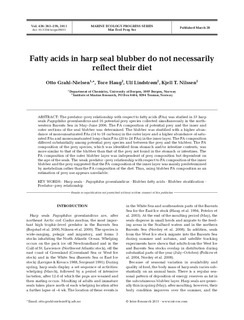| dc.contributor.author | Grahl-Nielsen, Otto | |
| dc.contributor.author | Haug, Tore | |
| dc.contributor.author | Lindstrøm, Ulf | |
| dc.contributor.author | Nilssen, Kjell Tormod | |
| dc.date.accessioned | 2011-11-23T18:39:07Z | |
| dc.date.issued | 2011-03-28 | |
| dc.identifier.issn | 0171-8630 | |
| dc.identifier.issn | 1616-1599 | |
| dc.identifier.uri | http://hdl.handle.net/11250/108740 | |
| dc.description.abstract | The predator–prey relationship with respect to fatty acids (FAs) was studied in 57 harp seals Pagophilus groenlandicus and 16 potential prey species collected simultaneously in the northwestern Barents Sea in May–June 2006. The FA composition of potential prey and the inner and outer sections of the seal blubber was determined. The blubber was stratified with a higher abundance of monounsaturated FAs (14 to 18 carbons) in the outer layer and a higher abundance of saturated FAs and monounsaturated long-chain FAs (20 to 24 FAs) in the inner layer. The FA composition differed substantially among potential prey species and between the prey and the blubber. The FA composition of the prey species, which was identified from stomach and/or intestine contents, was more similar to that of the blubber than that of the prey not found in the stomach or intestines. The FA composition of the outer blubber layer was independent of prey composition but dependent on the age of the seals. The weak predator–prey relationship with respect to FA composition of the inner blubber and the prey suggested that the FA composition of the inner layer was mainly predetermined by metabolism rather than the FA composition of the diet. Thus, using blubber FA composition as an estimation of prey use appears unreliable. | no_NO |
| dc.language.iso | eng | no_NO |
| dc.publisher | Inter-Research | no_NO |
| dc.subject | harp seal | no_NO |
| dc.subject | grønlandssel | no_NO |
| dc.subject | fatty acids | no_NO |
| dc.subject | fettsyrer | no_NO |
| dc.title | Fatty acids in harp seal blubber do not necessarily reflect their diet | no_NO |
| dc.type | Journal article | no_NO |
| dc.type | Peer reviewed | no_NO |
| dc.subject.nsi | VDP::Agriculture and fishery disciplines: 900::Fisheries science: 920::Aquaculture: 922 | no_NO |
| dc.subject.nsi | VDP::Mathematics and natural science: 400::Zoology and botany: 480::Marine biology: 497 | no_NO |
| dc.description.embargo | 2016-03-28 | |
| dc.source.pagenumber | 263-276 | no_NO |
| dc.source.volume | 426 | no_NO |
| dc.source.journal | Marine Ecology Progress Series | no_NO |
| dc.identifier.doi | http://dx.doi.org/10.3354/meps09011 | |
